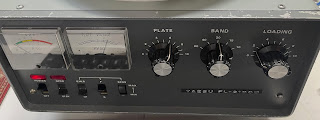Bringing the 285 Tech Connect Radio Club's "TechNet" into the digital realm
As some of you already know, I head up the 285 Tech Connect Radio Club (NA0TC) based in the Denver, Colorado area. Our club, founded in 2005, is dedicated to advancing the technical aspects of the hobby and technical skills of our members. To that end, we run a "TechNet" every Tuesday evening at 1900 (7pm) mountain time. The net, which has been hosted by Robb Sutter KC0ZGK for so long that even Robb can't remember how many years he's been running it.
We have been running the TechNet on an analog repeater hosted by another radio club in the Denver area, Colorado Repeater Association (W0CRA). The repeater we've been using, which operates on 145.145 MHz and is located 20 miles West of Denver atop Mestaa’ėhehe Mountain at 11,440' altitude, has amazing coverage across the Denver metro area and out to the Eastern Colorado plains. I'm not exactly sure how long we've used this repeater, but it's a very long time.
As with all RF repeaters, there are dark coverage spots, particularly in the Denver foothills and mountains to the West of the repeater, and given that our club was founded in the foothills (285 is a major route into the mountains from Denver), a number of our members aren't able to access the repeater. There are also a number of our members (myself included) who travel frequently, and I'm also not opposed to allowing out-of-state folks join the club. This led me to begin thinking about ways to extend the net's reach using digital protocols.
So, I approached the folks at CRA to see what our options could be. I was connected with Nate Duehr WY0X, who came up with the idea of bridging the club's UHF repeater, which is located on the same site as the 145.145 repeater, to the VHF side. The advantage of doing this is that the UHF repeater has an EchoLink node connected to it (W0CRA-L). So, a couple of weeks ago, we did a trial run during the TechNet with the two repeaters bridged and one of our club members, John Stevens WB4HZA was in Tampa Florida and was able to successfully join and participate in the net using the iOS EchoLink app. Success!
Next, Nate and I started discussing how to add a digital mode to the net. Fortunately, he has experience in doing this, and was able to set up a Pi-Star hotspot with DMR and connected to a talkgroup that the CRA has on the TGIF network. We ran that test this week, which also worked. Fortunately, John also has a DMR radio and a hotspot in Tampa, so he again was able to help us test the connection. I also joined the net using my Radioddity GD-77 DMR HT through a Pi-Star hotspot. Quality was pretty good; folks on the analog side sounded a little odd on the digital side (kind of like they had a head cold) but were very readable. Folks on the analog side also reported that voice quality from the digital side was good, other than one person who joined and had his audio gain cranked up too high.
My next step was to figure out how to set up our own DMR talkgroup for the club. First step was to request a DMR RadioID (from radioid.net) which required an official copy of the club callsign's FCC certificate. It look a little work to find the FCC ULS login, but we figured it out.
After hearing that Brandmeister is difficult to work with, I decided to apply for a TGIF talkgroup, which was super easy. The TGIF folks are awesome and easy to work with. However...Brandmeister is the gold standard for ham radio DMR, so I decided to see what I could do. After sending a support request to Brandmeister, I was informed that they no longer assign talkgroups but it's possible to just use the club's DMR ID (3215003) as a talkgroup with no setup required. PERFECT!
Today John and I gave this a try, and it worked great. We just configured our hotspots for Brandmeister, connected to talk group 3215003, and had a great QSO. So the plan is to continue running with this option.
Next, I wanted to see if I could figure out a way to enable Yaesu System Fusion (YSF, also known as System Fusion) radios to join the net. I know that several hotspots, including Pi-Star and OpenSpot 4, support cross-mode transcoding, so I did some research on the Pi-Star side, since I have three Pi-Star hotspots. As it turns out, it's pretty easy! Pi-Star includes a mode called "YSF2DMR" designed for exactly that purpose. After reading a couple articles on how to do it, tonight I was successful in configuring my YSF Pi-Star hotspot to work with our DMR talkgroup!
I'll write up detailed info on how to get Pi-Star working with our talk group using both DMR and YSF in a separate blog post. I'm very excited to have all of this working, especially since I'm about to hit the road and it will be great to give this a true test!



Comments
Post a Comment